|
Season 2 • Episode 11 - June 12, 2023
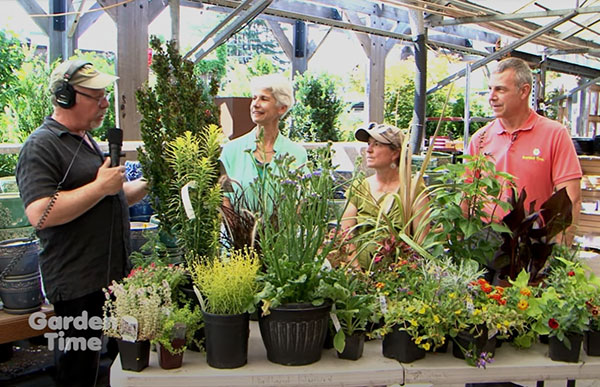
If you have colorful containers that
you put together in the spring, you may notice that they
are looking a little tired now as we approach summer.
Or, you might be thinking of building a fresh container
for the warm days ahead. Well, to get some ideas for
doing both we stopped by
Portland Nursery on Stark Street in Portland, Oregon
to talk with Laura, one of their plant experts and a
wholesale grower, to get some ideas for summer plant
combinations for planters and containers. Laura had put
together some great combinations of different types of
plants for us to share.
Before we begin, lets talk about a basic rule for
planting containers that will assist you in making your
plant selections. This is the rule about ‘thrillers’,
‘fillers’ and ‘spillers’. These refer to the types of
plants you select when planting.
A ‘thriller’ is the main plant in your container. This
is the focal point of your planting. People usually
choose a large distinctive plant to start building
around. It can be an annual, though most people pick a
large perennial, a dwarf tree or a shrub to start with.
Remember this is a container and so you can plant
whatever you like and replace it later. The key is to
get a container big enough for the plants you choose and
allow extra room for growth.
A ‘filler’ is one or more plants that will fill in
around the larger ‘thriller’ plant. These can have
complimentary or contrasting colors and textures
depending on what you want to achieve or your personal
preferences. They can be blooming plants or even just
plants with great texture to their foliage.
A ‘spiller’ is a plant that will spill over the sides of
a container to soften the edges of the pot and extend
the color palette or look that you are trying to
achieve.
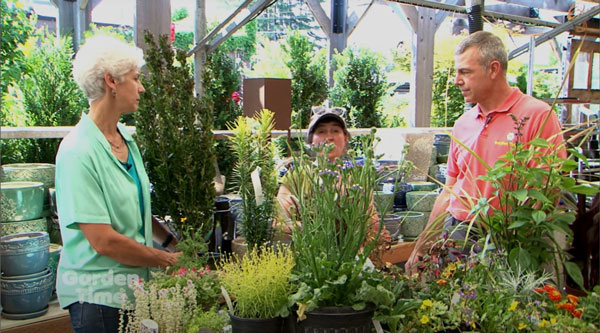
Laura started with some plants that have a tropical
theme. Some of these are tropical in nature and others
just have a tropical look to them. The first plant was a
‘thriller’. It was a Tropicana ‘Black Canna’. The black
and burgundy leaves offset the deep red flowers that
form in the mid-summer and last all the way into fall.
It may need some protection in the colder climates, but
can do well in a larger pot, as it can get six feet tall
by the end of the season. Another ‘thriller’ plant was a
dwarf papyrus called ‘Prince Tut’. It has strong green
stalks with puffs of fine foliage at the tips. The fine
foliage is a nice contrast to the broad leaves of the
canna. Next we moved to a couple ‘filler’ plants. Cuphea
‘Firecracker’ was on the table and it is also called a
bat faced cuphea because the flowers look like little
bats, with its deep red and purple flowers. It is a
hummingbird magnet and blooms continuously all summer
long. Another filler plant is the Marguerite Sweet
Potato Vine. This one not only fills in space in your
container, but also is a ‘spiller’, as it will also
spill over the sides of the container. Some other plants
that fill and spill are a Supercal ‘Premium Bordeaux’, a
cross between a calibrachoa and a petunia, and a regular
calibrachoa. The blooms on the Supercal are about three
times the size of the calibrachoa and a deep burgundy,
while the calibrachoa’s smaller blooms had more color
variations.
We also talked about textures and how they can create an
interesting look for your containers. Mixing large,
solid leaves with those that have a finer, lacy texture
can make your planter even more beautiful.
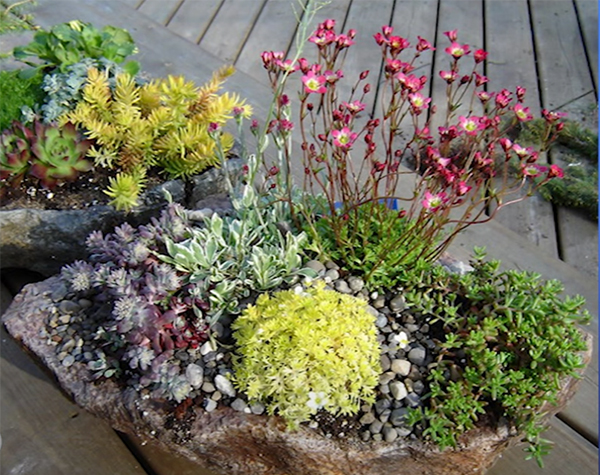
We followed-up with planting instructions. Dig a hole as
deep as your plants (not deeper), and twice as wide.
Amend the soil with a good garden compost and starter
fertilizer (E.B.Stone Sure Start is a good one) and add
an all-purpose, slow release fertilizer like Clean Water
Grow. This is a great fertilizer that is made locally
and reclaimed from waste water.
We did a story on it a few years ago on the TV show.
It is a cool product. Once your container is planted you
will want to supplement it with a liquid fertilizer
about every 10 days to two weeks to keep those blooms
coming! Laura uses Fox Farm Organic Liquid Plant Food
‘Big Bloom’. Other tips include using a quality potting
soil and not just soil from your garden. Using a good
potting soil reduces the risks of transferring pests and
diseases from our garden to your container. Also, don’t
forget to check the moisture of your pots and containers
regularly. If they dry out too much you may need to soak
the container deeply to recover your plants. The soaking
will help to expand the dried out root ball. If the pot
is really dry, the root ball shrinks and the water will
drain around the root ball and out the bottom without
watering the plants.
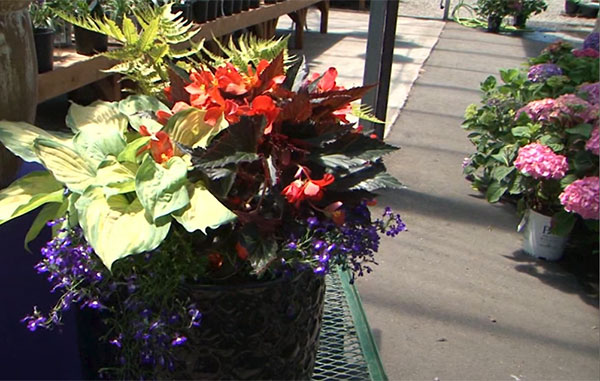
Laura then showed us a couple more combinations that we
can consider. Her next example had a mixed theme
consisting of drought-tolerant plants that Ryan noticed
were great pollinator plants, too! The first plant was
Rockin Salvia ‘Blue Suede Shoes’ with large blue blooms
that are a hummingbird magnet. They get about 40 inches
high so it becomes your thriller. The next layer down is
the Helichrysum icicle. The lacy, silver foliage is a
nice contrast color to the salvia and it will brighten
up your container as well. If you are looking for blooms
to go with that great foliage, check out the other
filler, lantana. This plant loves the heat and will pop
with pom-poms of bright, two-toned flowers of orange and
yellow. The spiller for this container was a trailing
portulaca (purslane) ‘Pizzaz Yellow’. The thick leaves
hold in the water which makes it perfect for a drought
tolerant planter. It goes well with the other spiller
Scaevola, or Fan Flower.
The next group was a partial shade combination. She
started with a Cordyline with its tall grassy structured
leaves. The variety was ‘Cha cha’ with color streaks of
coral, peach, lime and pink in the leaves. The pink
worked well with a coleus ‘French Quarter’, whose leaves
had pinks, burgundy and lime colors in the leaves. The
next plant layer included a begonia, ‘Mistral Yellow’.
This one is semi-trailing, meaning that it starts to
grow upright and then falls into a trailing vine. The
yellow flowers have a peach color on the back of the
blooms, once again tying everything together. A true
spiller was our final plant for this combination. The
Diascia ‘Piccadilly Apple Blossom’ has dainty white/pink
flowers that will also help soften the edge of the pot
you use. These bright colors were great for a partial
shade container to help it look great in the dark areas
of the garden.
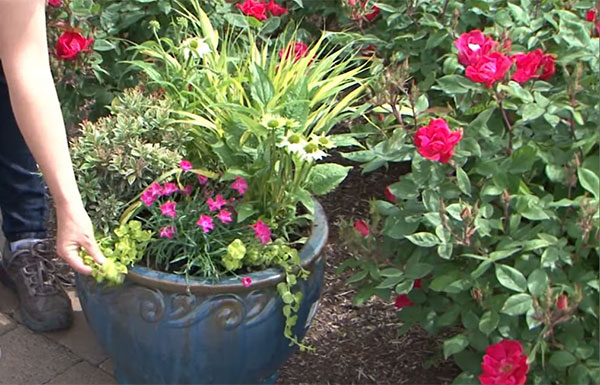
Laura also likes cut flowers so she had a container that
was just for cut flowers. In this container she had two
different types of ‘dried looking’ flowers. The
Xerochysum, or Straw Flower, opens into a dried stiff
bloom and is great for long-lasting bouquets and
arrangements. She also included a Statice flower (also
called Sea Lavenders) which has an upright structure and
tinier bloom. In addition, she planted Purple Fountain
Grass. It has seed heads that look like bunny tails and
can create a softness and motion when used in
arrangements.
The final combinations were all centered around a
perennial ‘thriller’ or focal point. Then she picked
colorful annuals to plant around the base of those
taller plants. These annuals can be changed out
according to the season to freshen up your pots and
containers. For a shadier area she picked a tall Yew.
This one was the Gold Plum Yew, with bright gold, new
growth. It was a tall columnar plant which she
recommends for containers so you have room for other
plants underneath. Another tall perennial was a Holly,
Ilex crenata ‘Ruby Colonade’. The dark red foliage is
shiny and turns burgundy over time. The understory
(lower level) plants were not only beautiful in color,
they also had various fragrances! Laura called them her
‘scratch and sniff’ plants. The first was Santolina
‘Lemon Fizz’. The bright, lime green, lacy foliage is
topped by tiny little balls of color and it has a
camphor smell to it. She had a scented Geranium on the
table as well. These are not your regular type geranium,
but generally have a smaller leaf and finer, small
blooms. This one was compact and had tiny flowers. It
also has a minty smell to the foliage, but you can find
different varieties with different smells and textures
too. A tall plant that has fragrant foliage was next. It
was a Lemon Gem marigold. It has a fine foliage with
tiny, single, bright orange blooms. The foliage has a
citrusy smell that was pretty strong. We finished with
some thymes. The Silver Posie has a taller structure
(around a foot tall or less) and a variegated foliage
and a small lavender flower. The small ‘Lime’ variety is
a deep rich green with white flowers. Thymes will return
year after year and are a great pollinator plant for
bees.
These were just a few combinations for pots and
containers that you can find at Portland Nursery and a
lot of your local independent garden centers. If you are
looking for more great helpful hints and container
combination suggestions,
check out the Portland Nursery resources page for some
wonderful brochures that you can download and print out,
or you can stop by either location in the Portland,
Oregon metro area.

PODCASTS
2022
• Return to Current Year Podcast List
 |